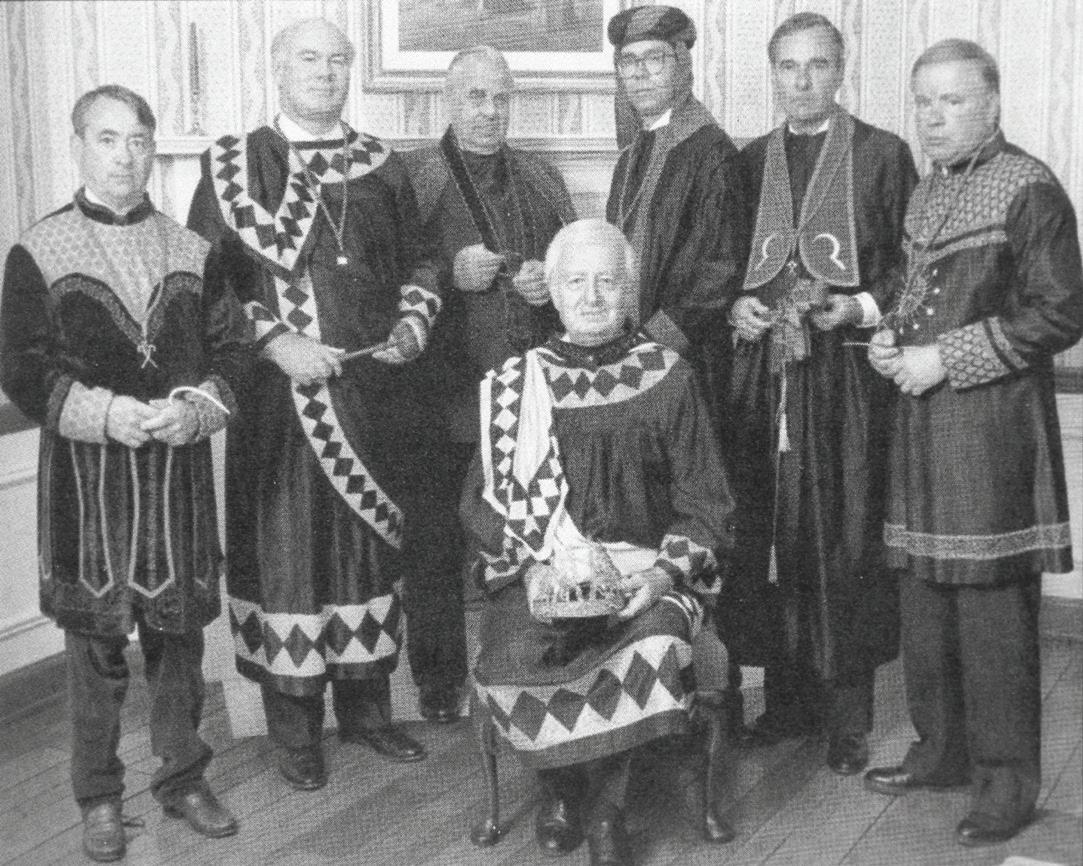
13 minute read
The Rituals
Eayrs recounted a few months later at the fi rst convention how the fi ve men met in a corner of the printing offi ce “using a $1.50 kitchen table” as their desk, where they discussed Slocum’s plans carefully and agreed to proceed. Once that decision was made, events moved rapidly. On Aug. 5, the fi rst meeting of farmers was held in the England schoolhouse fi ve miles north of Caro. Almer Arbor Number 1 was formed from the nearly 50 people who attended the meeting. Almer Arbor was later combined with June Arbor Number 9 and became known as Caro Arbor Number 1.
Early Gleaner regalia used in presenting the Dramatic Degree was modeled by o cers in the 1990s. Standing, left to right: Vernon Howard, Richard Livesey, Joseph Burnett, Michael Wade, Ellsworth Stout and Bill Warner. Seated: Frank Dick.
Advertisement
The Ancient Order of Gleaners was a secret society with passwords, a formal ritual, a secret handshake, a progression of degrees, and an oath binding the members to a common bond.
Secret societies have a long and interesting history in the United States. Occasionally they became controversial because they were seen as elitist and, therefore, outof-step in a democratic country. Stories about lodge secrets circulated among non-members, some of them quite sensational. As secrets were released to the public by dissident members a few church leaders began to openly attack all secret societies. They charged they were illegitimate religious bodies because of the use of prayer and religious symbols in the rituals. Some even issued edicts warning members not to join under penalty of excommunication.
Opposition to secret societies even led to the formation of a political party. The Anti-Mason party, the fi rst “third party” movement in the United States, appeared as Andrew Jackson was running for his second term as president in 1832. Jackson was the target of the Anti-Masons since he was a member of that organization. The party started in western New York state and left its mark by holding the fi rst political nominating convention. In the 1850s the American or “Know Nothing” party was created by a secret society called The Order of the Star-Spangled Banner. It opposed immigration and was anti-Catholic. Both parties disappeared in short order, but secret societies continued to fl ourish and their critics continued to oppose them.
In one important way the Ancient Order of Gleaners was diff erent from other secret groups. The success of the Society depended on recruiting large numbers of new members. Although membership was restricted to farmers, all “agriculturists” were encouraged to join. Success meant bringing people in, not keeping them out. Slocum liked to quote the poem “Outwitted” by Edwin Markham to illustrate his point:
“They drew a circle to shut me out — Heretic, rebel, a thing to out. But Love and I had the wit to win; We drew a circle that took him in.”
As a member of the Masons, the International Order of Odd Fellows, and the Grange, Slocum was familiar with the rituals of those organizations. He drafted the Gleaner rituals along those lines, using ideas from several existing organizations. He was an idealist as well as a populist, and those qualities are clearly present in the Gleaner rituals. He believed farmers were too isolated from each other, and that they must be brought together in a common cause. He also believed people needed something to add dignity to their lives, and the Gleaner rituals were written with that thought in mind. Farmers would respond, he insisted, to a call for high ideals.
Slocum began writing the Gleaner rituals in 1888 at the time he fi rst tried to organize the Ancient Order
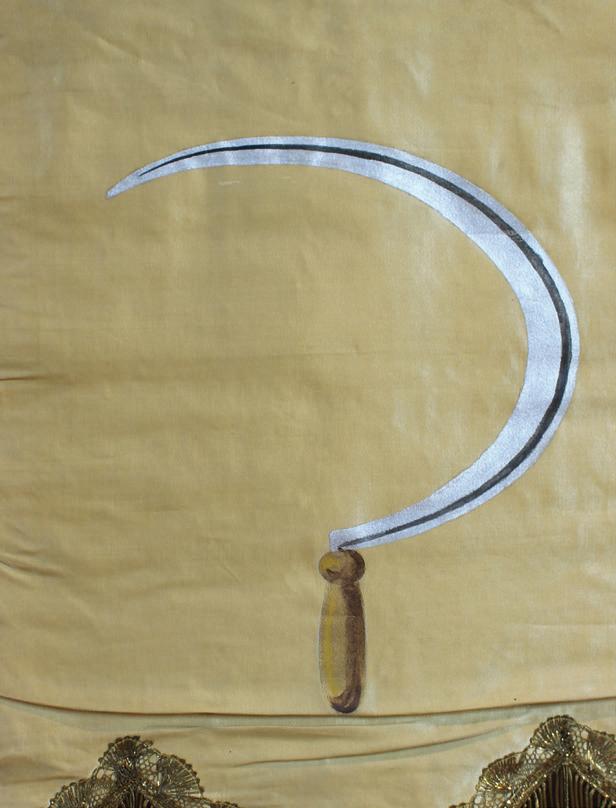
The Sickle The Sheaf The Hour Glass
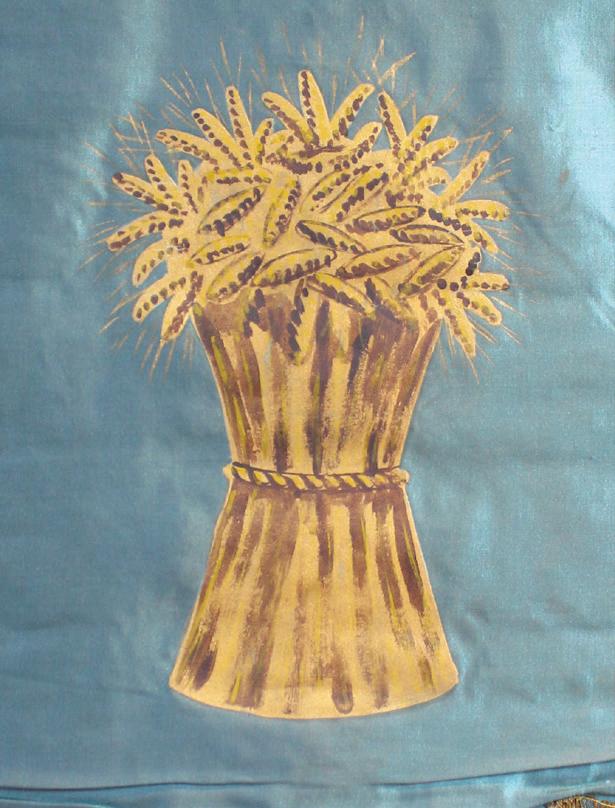

of Gleaners. They were not completed until the spring of 1894. He chose prudens futuri as the motto, a Latin phrase meaning “thoughtful for the future.” It was a good choice since it expresses the family values common to Midwestern farmers. The motto also provides a logical foundation for the Society’s insurance program. As principles for the new society he chose Benevolence, Protection and Fraternity.
The rituals (in part) explain Benevolence as: “… a sister of Charity, and the golden bow of promise that spans the heaven of infi nite love. Benevolence, like the diamond set in circles of gold, sparkles with brilliancy amid the gloom of the night of sorrow and affl iction. Benevolence dwells in the hearts of all who are true and noble. It knocks on the doors of the rich, but oftener crosses the threshold of the poorest hut and home to administer to the wants of the poor and needy. It goes to the widow and relieves her woe; to the orphan in time of need; to the sick and suff ering to comfort and cheer.”
The second principle, Protection, was: “… most beautifully exemplifi ed in the pledge of Ruth to Naomi: “Entreat me not to leave thee or return from following after thee, for whither thou goest I will go, and where thou lodgest I will lodge; thy people shall be my people and thy God my God.” Further, “By mutual ties and our plan of cooperation we have accomplished more good for the farmer and his cause than any other society.” The third principle, Fraternity: “… simply means love and true sympathy for our fellow man. Furthermore, ours is a great co-operative fraternity based upon equality, wherein all have equal rights, equal benefi ts and equal privileges.”
Three symbols were chosen to represent Society ideals:
The Sickle: “It represents an honest occupation and is a constant reminder of the keen blade of ‘Father Time’ who eventually cuts us all down.”
The Sheaf (of wheat). The Sheaf is described as: “Appropriate companion to the Sickle, is used by us to typify both our principal occupation and the fabric of our order. Each single straw in the Sheaf is necessary to form a perfect whole which becomes a thing of beauty and strength.”
The Hour Glass: “Because of the certainty of that harvest season, when all must be cut down by that Grim Reaper, we are wont to use the Hour Glass as a symbol of the fl ight of time.”
The three symbols of the order were prominently displayed at arbor meetings, and the three principles were also used in the ceremonies initiating new members. Members in good standing were called “Companions.”
Women of Gleaner
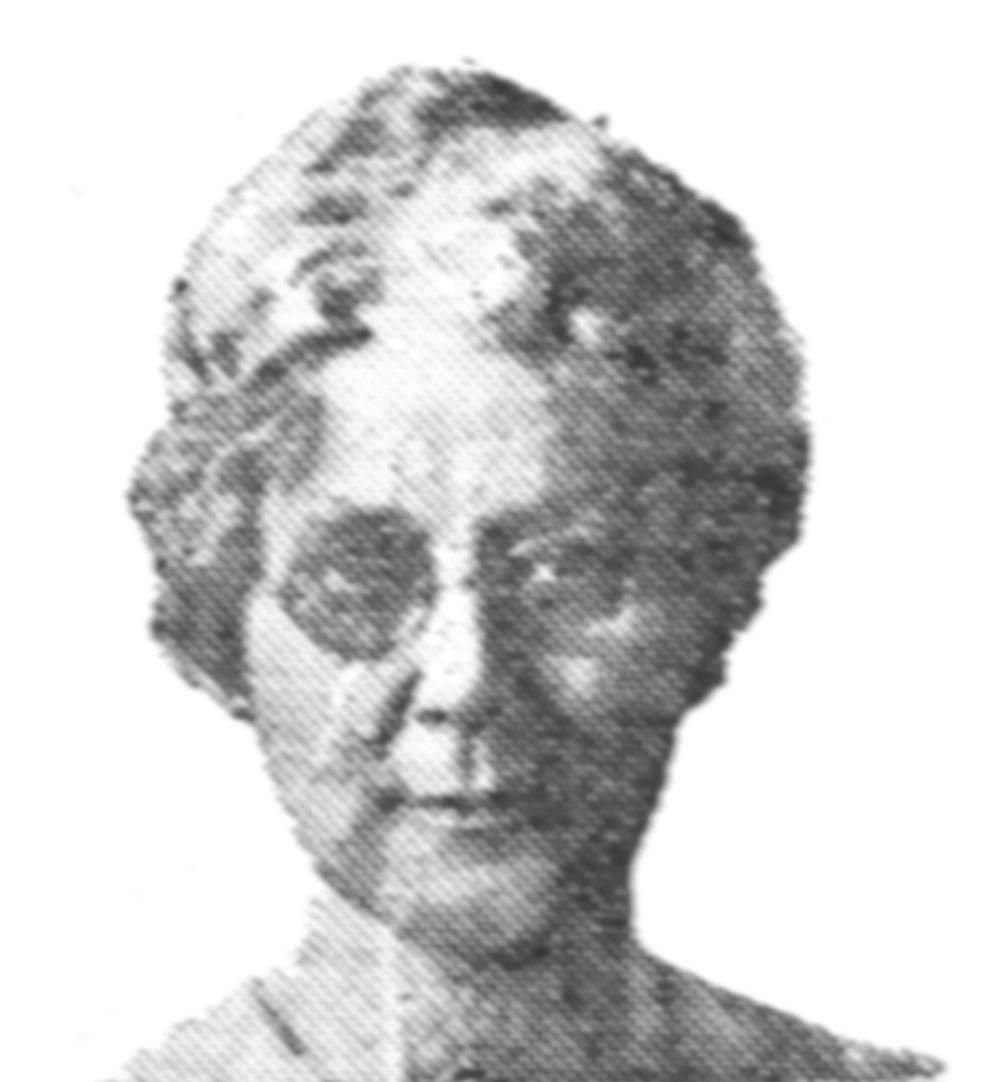
Ada F. Theobald
Ada F. Theobald not only holds the distinction of being the Gleaner Society’s fi rst employee, for a time she also was its only employee.
“Miss Ada Theobald, head bookkeeper, was at one time the only employee at Gleaner headquarters, and she handled all of the work successfully,” reported a 1918 profi le, adding that “at the present time it requires a force of nearly forty employees to handle the business of the Order, and the transactions of a single hour exceed in volume the business of a month in the long ago.”
Theobald was born in Caro, Michigan, July 29, 1864. “Miss Theobald accepted her fi rst position with Grant Slocum when he founded the Gleaners, her position being recorded in her original application as ‘Assistant Secretary State Arbor’,” her obituary reported. (In 1894, and the fi rst few years following, the “State Arbor” was the name given to the Home Offi ce.)
Theobald moved from Caro to Detroit with her mother when the Home Offi ce relocated Jan. 1, 1909, to the newly built Gleaner Temple on Woodward Avenue. She remained head bookkeeper until her retirement in the summer of 1934 after four decades of service. She died March 28, 1940, in Highland Park after a long illness, and is buried in Caro. Each local Arbor and the State Arbor (renamed the Supreme Arbor after the Society expanded outside of Michigan) elected the following offi cers: Chief Gleaner Vice Chief Gleaner Chaplain Conductor (and Conductress) Lecturer Inner Guard Outer Guard Secretary-Treasurer
The monthly meeting of the local arbor was held in a home or, if the group was prosperous, in a Gleaner hall. Sometimes a Grange hall or a public building was used if the size of the membership warranted. Usually the meetings were held on a Tuesday or a Wednesday evening.
The rituals were revised somewhat in 1915. After that date an arbor meeting would look and sound something like this if held in a Gleaner hall:
The Chief Gleaner and Vice Chief Gleaner sat facing each other from opposite ends of the hall. They may or may not have been dressed in costumes appropriate to their o ce. In the center of the hall was an altar with a closed Bible with a Sickle placed on it. The Chaplain sat opposite the altar to the left of the Chief Gleaner. Directly opposite the Chaplain sat the Lecturer. The Conductor and the Conductress were stationed at the altar. The Secretary-Treasurer sat at the right of the Chief Gleaner and the choir on his left. Behind the Vice Chief Gleaner were two rooms through which everyone had to pass to enter the hall. The Outer Guard was stationed in the rst room and the Inner Guard in the hall but near the door to the second room. Once the meeting began the doors were closed and not even members could enter the main hall.
An opening ceremony was held including a prayer and the singing of a song prescribed in the ritual. The songs were written to familiar melodies, the rst to “America the Beautiful” and the second to “What a Friend We Have in Jesus,” a church hymn.
The Order of Business consisted of 15 items.
After the roll call of o cers and the reading of minutes, the question was asked, “Does anyone know of a Companion sick or in distress?” If the answer was yes, o cers made a note to pursue the matter after the next meeting. Items 4, 5 and 6 concerned applications for membership and the balloting. Voting on new members was done by placing a white marble (for “yes”) or a black one (“no”) in a ballot box. Three negative votes meant rejection. Agenda item 7 was the initiation of new members.
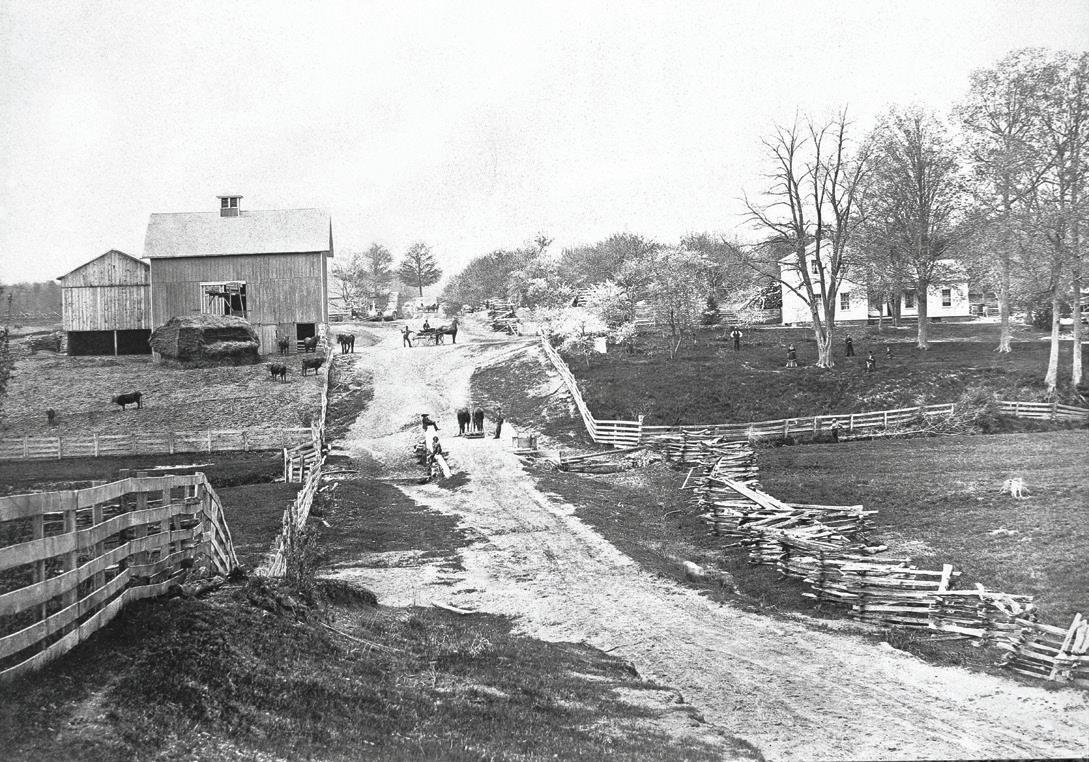
Items 8 through 11 in the Order of Business concerned committee reports and the payment of bills. Item 12 was the payment of dues and assessments. (Until Gleaner headquarters started collecting insurance premiums directly from members, all assessments were paid in this fashion.) Next came an item called “Good of the Order” (Item 13) followed by the Secretary-Treasurer’s report (Item 14) and the Closing Ceremony (Item 15).

The Closing Ceremony was begun with the Chief Gleaner saying, “Companions, once more we are about to mingle with the outside world. Let us so live and regulate our conduct that others, seeing our good works, may join with us in this great cooperative brotherhood.” The Conductor then assembled the members in the Gleaner Defending Circle around the altar. The Chief Gleaner faced the altar across from the Vice Chief Gleaner with the Lecturer on his left and the Conductor on his right. In answer to the question, “What is the aim and object of this order and the duty of every worthy Companion?,” the members responded “To assist worthy Companions in distress, to provide for the widows and orphans, and to cooperate for the advancement of the cause of the agriculturist and the up-building of his calling.” The members completed the closing ceremony by singing a song written to the tune of “Auld Lang Syne.” The final spoken words were, “Blessed be He of the Lord Who hath not ceased His kindness both to the living and the dead.” There were four “degrees” in the Gleaner ritual. The fi rst, called the Degree of Introduction and Obligation was required of all candidates. The Adoption Degree, Ruth’s Degree, and the Dramatic Degree followed in that order. In addition to the fi rst degree all Gleaner members had to experience at least one of the last three. All female members took Ruth’s degree or the Adoption degree, and the arbor chose between the Adoption degree and the Dramatic degree for the men. The degree ceremonies were colorful, very dramatic, and were designed to instruct the members in the Gleaner philosophy.
The rituals also included special ceremonies for the installation of new members, a Burial Ceremony, a Memorial Ceremony, and certain Drill Forms.
A certain part of the ritual was never written or published but instead passed on by word-of-mouth. Called the “Unwritten Work,” it was transmitted through a code based on numbers.
Several revisions of the rituals were made between 1915 and 1961. One of the revisions, in use after Jan. 1, 1927, made a signifi cant cant change in the prayer
There were four “degrees” in the Gleaner ritual. The fi rst, called the Degree of Introduction and Obligation was required of all candidates. The Adoption Degree, Ruth’s Degree, and the Dramatic Degree followed in that order. In addition to the fi rst degree all Gleaner members had to experience at least one of the last three. All female members took Ruth’s degree or the Adoption degree, and the arbor chose between the Adoption degree and the Dramatic degree for the men. The degree ceremonies were colorful, very dramatic, and were designed to instruct the members in the Gleaner philosophy. The rituals also included special ceremonies for the
Koylton Arbor Hall, located ve miles south of Kingston, Michigan. The hall was dedicated December 20, 1894, and is believed to be the rst arbor hall.
One successful Michigan farm prior to 1900 was the Van Ness Schermerhorn farm near Pittsford, pictured in 1875. Helping other agricultural communities reach prosperity became the goal of the Ancient Order of Gleaners. (Photo Credit: Hudson Museum collection, Hudson, Michigan)
installation of new members, a Burial Ceremony, a Memorial Ceremony, and certain Drill Forms. A certain part of the ritual was never written or published but instead passed on by word-of-mouth. Called the “Unwritten Work,” it was transmitted through a code based on numbers.
Several revisions of the rituals were made between 1915 and 1961. One of the revisions, in use after Jan. 1, 1927, made a signifi cant change in the prayer used in the Opening Ceremony. The phrases “fatherhood of God” and “exemplify in our daily lives the teachings of Jesus, Thy dear Son” were deleted. The change was probably done to bolster the Society’s claim to be non-sectarian in religious matters. In the 1961 revision the Outer Guard and Inner Guard were combined. The Order of Business was changed to delete the practice of collecting insurance premiums at meetings. Some of the language was simplifi ed and some of it deleted entirely. In the Opening Ceremony, for example, the section called “Giving Password and Admitting Strangers” was completely eliminated. The singing of “America …” was substituted for the Odes required of the old ritual.
Short form rituals were adopted in May 1949 “for those who, because of religious or other reasons do not wish to substitute ritualistic ceremonies.” A Junior Gleaner department was started in the 1920s while Ross Holloway was president (see Chapter 5). Separate rituals were developed for Junior members.
Gleaner rituals have changed more than any other part of the organization, largely because American society itself has changed. The Gleaner meeting was once a major part of family entertainment and served to bring people together who might otherwise not have seen much of each other. The meeting was a forum to discuss community issues. As 20th century technology radically expanded entertainment and information after World War I, the meetings and the rituals were seen as old-fashioned and out of tune in a changing world.
Not so strangely, many people search for the values held by their fathers. They can fi nd them in the Gleaner rituals.

Early Gleaner rituals included “degrees” for each member, and were presented like a short play using costumes. The women of the Broom eld Arbor team in Isabella County, Michigan, in the 1920s were shown in costume for Ruth’s degree.
15
16










